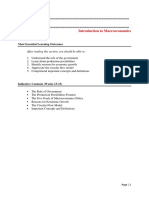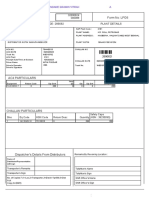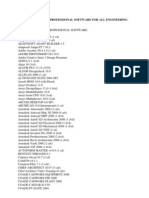ECON 1202 - Problem Set 1
ECON 1202 - Problem Set 1
Uploaded by
neelpatel3415Copyright:
Available Formats
ECON 1202 - Problem Set 1
ECON 1202 - Problem Set 1
Uploaded by
neelpatel3415Original Description:
Original Title
Copyright
Available Formats
Share this document
Did you find this document useful?
Is this content inappropriate?
Copyright:
Available Formats
ECON 1202 - Problem Set 1
ECON 1202 - Problem Set 1
Uploaded by
neelpatel3415Copyright:
Available Formats
Part I: (a) The microeconomic model discussed in lecture describes the basic day-to-day economics portrayed in this world
by the regular working consumer and it can also help describe the structure of economic dynamics. In a basic look at this model, it involves the common household(s) and firm(s). In order for the firm to run and make money, they need to hire employees to carry out their duties, and the citizens need a job to obtain a salary to pay for any goods and services. This aspect of the model is part of the labor market. The model takes a circular approach because the firm pays a salary to the household in return for their labor. The households then take their salary and give money to firm for their goods and services. This aspect of the model is part of the production/goods market. However, in most cases all of the salary that the households obtain from their firm, they do not spend all of it. They then take their savings and invest their extra money into the firms. When the firms earns money they are able to pay dividends back to those who invested in their firm. Dividends are considered to be part of the capital market. Another aspect of this model that also falls into macroeconomics are the institutions that play a major role. One institution is government which give firms and households security and certain benefits in return for taxes. Banks give firms loans and these firms pay interest in return for the loans. Households give their savings to the banks who pay the households interest for the money they keep in the bank. This structure of economic dynamics is what keeps money flowing and gives incentive to the different parties. (b) Although macroeconomics and microeconomic both fall under the category of economics, they are very much different. Microeconomics is the study of a more individualistic aspect of consumerism and incentive to buy things. Microeconomics focuses primarily on single individuals or companies and the prices and decisions that go along with each. As we have seen in the microeconomic model, it relies on labor and production. It also focuses much on supply and demand Macroeconomics, however, is a more broad and aggregate level of such behaviors and decisions as they impact the entire economy, instead of just single people of firms. Some of the major points to macroeconomics are inflation, unemployment, and output growth. Because macroeconomics is so broad and looks at entire economies, it compares different nations and their GDP and other measures of national output and income.
Part II: (a) Economics can be looked at in two different ways: positive or normative approaches. Each approach has its use for economists. The positive approach is based on factual evidence and a more objective undertaking. It looks at things as they are and relies on evidence that can be tested and experimented on multiple times. Positive economics is what is mainly used to explain economic situations and describe certain theories. It is much more reliable compared to the normative approach. The normative approach is more opinion and observation based. It is explained as what ought to be or what you think it should be. Normative economics more often than not used to make decisions about the future of the economy based on judgement. It cannot be proved or tested so it is based more on personal views. Since this approach very much incorporates value judgements, it is the type of approach that you will often see and hear because of the openness and room for opinion. An example of each approach that does not have to do with economics is how a baby is born. According to the positive approach, babies are born after a male and a female reproduce and the males sperm and female eggs come together and what not. A normative approach to this would be that a stork came and delivered a new baby to the parents, something that many parents might tell their adolescent children. (b) It is true that theoretical and empirical physics are both science, but that does not necessarily mean that they are both positivism. Theoretical physics, according to Wikipedia, is a branch of physics which employs mathematical models and abstractions of physics to rationalize, explain and predict natural phenomena. This is in contrast to experimental physics, which uses experimental tools to probe these phenomena. Therefore, it would not be considered positivism because it predicts based theory and not experimental facts. Empirical physics on the other hand is based on raw data and facts which would characterize it as positivism. (c) Economics is extremely intertwined and can be positive and normative depending on the context. Macroeconomics seems to be more positive as it deals more with data at an aggregate level and between nations. Although microeconomics does use data as well, there is much normative aspect because it tries to predict the future of the economy at an individualistic level.
Part III: (a) GDP stands for Gross Domestic Product. Gross Domestic Product is value of all goods and services sold as final goods in a certain country. It is the final sales plus the change in business inventory. Technically it is the output growth of a nation with regards to many aspects. There are two approaches to measure GDP: income and expenditure. The expenditure approach is a more logical and better approach and is calculated through a certain formula. In order to formulate the Gross Domestic Product, you must take the sum of consumption, investment, government, and export, subtracted by import costs. Consumption is based on durable and non-durable goods, and services sold throughout the nation. Investment consists of residential and non-residential investments into companies in that nation. The government aspect of this formula consists of government spending which could consist of infrastructure, research, etc. This is the easiest way to calculate nation output and income. GDP is also used to calculate many other important sets of data such as Gross National Product (GNP), Net Nation Product (NNP), Nation Income (NI), Personal Income, Disposable Income, Gross National Income (GNI), and GDP per capita which is an important tool in calculating a country's standard of living. (b) More often than not, the expenditure approach to measuring GDP is used compared to income approach because it is more efficient and takes into account only the final sales of all goods and services sold within that nation. Basically it easily takes how much is spent into one easy formula and is able to measure GDP. The income approach seems to be more complicated because it requires much more information such as compensation of employees, proprietors' income, rental income, corporate profit, net interest, indirect tax (minus subsidies), net business transfer payment, and surplus of government enterprises. Even though both methods should yield the same GDP, the expenditure approach is more reliable and efficient, therefore the reason most economists prefer that measure.
Part IV: (a) Deflation and and disinflation may seen to be similar, but they are actually very much different. Deflation is when prices drop over a period of time. This price can be for any goods or services but at a general level. Deflation is normally a bad thing when prices continue to fall. Deflation causes money to be worth more because you can get more goods and services from a certain amount of money. Disinflation on the other hand is similar to inflation because prices are increasing, but it is the slow down or inflation. Because the inflation rate is dropping but is still positive, it causes lower interest rates which is good for the economy. Another way to show disinflation is a decrease in the percentage of inflation over multiple periods of time. (b) A treasury bond has many differences and similarities as corporate bonds. First of all, a treasury is form of capital issued by the United States government. Corporate bonds are similar but they are issued by firms in order to collect capital for business purposes. The main difference between the two is the risk taken. With United States treasury bonds, there is little risk and is backed up but there could be little return. Corporate bonds, on the other hand, have a great deal of risk but can have pretty good rewards. The risk comes if the corporation that you buy a corporate bond from goes bankrupt, then you could lose the money you invested in the bond. Many people prefer corporate bonds for the reason that there could be great rewards. Also, another difference is the maturity date of the bonds. With US treasury bonds, the maturity date can last anywhere from 10 to 30 years while corporate bonds do not have as long of a maturity date.
You might also like
- Modelo de Curriculum Vitae en InglesDocument2 pagesModelo de Curriculum Vitae en InglesdouglaslibNo ratings yet
- Tutorial Chapter1Document4 pagesTutorial Chapter1Laurent Xue Zhi ChuanNo ratings yet
- Askari Aviation Services Marketing ReportDocument66 pagesAskari Aviation Services Marketing Reportsyed usman wazir100% (1)
- Cost of Reading Privacy PoliciesDocument18 pagesCost of Reading Privacy PoliciesPascal Van HeckeNo ratings yet
- EconomicsDocument6 pagesEconomicsmeighantoffeeNo ratings yet
- Part I: Essay QuestionsDocument10 pagesPart I: Essay QuestionsBRIAN GODWIN LIMNo ratings yet
- What Is 'Economics': Microeconomics - Focuses On How Individual Consumers and Producers Make Their Decisions. ThisDocument5 pagesWhat Is 'Economics': Microeconomics - Focuses On How Individual Consumers and Producers Make Their Decisions. ThisHelena MontgomeryNo ratings yet
- Macroeconomics (Answers)Document4 pagesMacroeconomics (Answers)sandra1484100% (2)
- Suyash Kulkarni Section - D Roll No.-2017143137: Assignment 1Document11 pagesSuyash Kulkarni Section - D Roll No.-2017143137: Assignment 1Suyash KulkarniNo ratings yet
- Literature Review of Monetary and Fiscal PolicyDocument8 pagesLiterature Review of Monetary and Fiscal Policyc5t0jsyn100% (1)
- Câu Hỏi TACN 1Document6 pagesCâu Hỏi TACN 1haiphongmeoNo ratings yet
- BIT 2120 Econ Notes 1Document24 pagesBIT 2120 Econ Notes 1kelvinkakuru2No ratings yet
- Econ 100b End of Chapter QuestionsDocument4 pagesEcon 100b End of Chapter Questionsishapunja97No ratings yet
- Introduction To Macroeconomics: After Reading This Section, You Should Be Able ToDocument33 pagesIntroduction To Macroeconomics: After Reading This Section, You Should Be Able ToKhaster NavarraNo ratings yet
- $R39WPD6Document20 pages$R39WPD6blairelallainaNo ratings yet
- Economic, Business and Artificial Intelligence Common Knowledge Terms And DefinitionsFrom EverandEconomic, Business and Artificial Intelligence Common Knowledge Terms And DefinitionsNo ratings yet
- Epa 005Document7 pagesEpa 005AakashMalhotraNo ratings yet
- Managerial Economics: Economic Way of Thinking:Learning For A ManagerDocument11 pagesManagerial Economics: Economic Way of Thinking:Learning For A ManagerAbhinav AggarwalNo ratings yet
- Unit 1Document13 pagesUnit 1Arrowhead GamingNo ratings yet
- BIT 2120 Econ Notes 1Document23 pagesBIT 2120 Econ Notes 1Onduso Sammy MagaraNo ratings yet
- BUS251 Macro Final Spring 2023bDocument9 pagesBUS251 Macro Final Spring 2023bΙΩΑΝΝΗΣ ΘΕΟΦΑΝΟΥΣNo ratings yet
- Managerial Economics - EssayDocument5 pagesManagerial Economics - EssayJohn JosephNo ratings yet
- Chapter 6 Solutions ManualDocument8 pagesChapter 6 Solutions ManualJialu GaoNo ratings yet
- Đề Cương Tiếng Anh Chuyên Ngành 1Document17 pagesĐề Cương Tiếng Anh Chuyên Ngành 1thngnNo ratings yet
- Lab 2Document9 pagesLab 2Ahmad AlNo ratings yet
- Public Finance Term Paper TopicsDocument4 pagesPublic Finance Term Paper Topicsafmzubsbdcfffg100% (1)
- Diamond, P. A., & Mirrlees, J. A. (1971) - Optimal Taxation and Public Production I, Production EfficiencyDocument21 pagesDiamond, P. A., & Mirrlees, J. A. (1971) - Optimal Taxation and Public Production I, Production EfficiencyGerald HartmanNo ratings yet
- Introduction To MacroeconomicsDocument4 pagesIntroduction To MacroeconomicsPeris WanjikuNo ratings yet
- James Montier WhatGoesUpDocument8 pagesJames Montier WhatGoesUpdtpalfiniNo ratings yet
- Bba 103 AssignmentDocument7 pagesBba 103 AssignmentjasonNo ratings yet
- Income and ExpenditureDocument5 pagesIncome and Expendituremusinguzi francisNo ratings yet
- Economics PaperDocument5 pagesEconomics Paperj9No ratings yet
- Chapter 1-4Document38 pagesChapter 1-4givaniaNo ratings yet
- KogyiDocument5 pagesKogyiDr.NayNo ratings yet
- Chapter 1-4Document38 pagesChapter 1-4givaniaNo ratings yet
- IntroductionDocument27 pagesIntroductionvisala30No ratings yet
- EconomicsDocument14 pagesEconomicsPawar Shirish PrakashNo ratings yet
- EconomicsDocument32 pagesEconomicsAnkit AgarwalNo ratings yet
- Principles of Macroeconomics Topic 1Document15 pagesPrinciples of Macroeconomics Topic 1peterkiamaw492No ratings yet
- UGC NET Paper - 2 Economics - CompressedDocument131 pagesUGC NET Paper - 2 Economics - CompressedKunal KashyapNo ratings yet
- Chapter 0Document4 pagesChapter 0Devita OctaviaNo ratings yet
- Handout - 3Document5 pagesHandout - 3Jarin TasnimNo ratings yet
- 7-Economics For EveryoneDocument17 pages7-Economics For Everyoneyawner9304No ratings yet
- Immediate download Macroeconomics Principles Applications and Tools 8th Edition OSullivan Solutions Manual all chaptersDocument48 pagesImmediate download Macroeconomics Principles Applications and Tools 8th Edition OSullivan Solutions Manual all chaptersnarintonks97100% (6)
- 1.principles of Macro EconomicsDocument4 pages1.principles of Macro Economicskrishnakishore7781No ratings yet
- Consumption and SavingsDocument18 pagesConsumption and SavingsAna Ionela ȚepeșNo ratings yet
- Benedicto, Kim Gabriel M. ECO 101 Bsmt32 - B1 Os Split Sir Delos Reyes Quiz #1 1. What Is Economics?Document5 pagesBenedicto, Kim Gabriel M. ECO 101 Bsmt32 - B1 Os Split Sir Delos Reyes Quiz #1 1. What Is Economics?Kim GabrielNo ratings yet
- Money Andthe EconomyDocument8 pagesMoney Andthe EconomyFhremond ApoleNo ratings yet
- đề 7Document8 pagesđề 7Hiền NguyễnNo ratings yet
- Vocabulary TacnDocument11 pagesVocabulary TacnLy PhạmNo ratings yet
- Tài liệu 8kDocument40 pagesTài liệu 8kkhoinguyen19.workNo ratings yet
- Finance - Function Matters, Not SizeDocument25 pagesFinance - Function Matters, Not SizeVicente MirandaNo ratings yet
- Microeconomics End QuestionsDocument5 pagesMicroeconomics End QuestionsJAMILLE BAUTISTANo ratings yet
- Trends in Consumption, Savings and Investment 1Document20 pagesTrends in Consumption, Savings and Investment 1Eashaa SaraogiNo ratings yet
- UNIT 2 Tutorial Questions and AnswersDocument6 pagesUNIT 2 Tutorial Questions and AnswersAlicia AbsolamNo ratings yet
- FinancialisatioDocument8 pagesFinancialisatioSoham KumNo ratings yet
- Principles of Microeconomics 1 (9301)Document16 pagesPrinciples of Microeconomics 1 (9301)Hucna YousafxaiNo ratings yet
- ĐỀ không có KeyDocument6 pagesĐỀ không có Keykhanhchipham96No ratings yet
- Subject Name: Economic Principles and Decision MakingDocument4 pagesSubject Name: Economic Principles and Decision Makingsimranpreet kaurNo ratings yet
- Chapter 1 - Introduction To Economic TheoryDocument12 pagesChapter 1 - Introduction To Economic TheoryMaria Teresa Frando CahandingNo ratings yet
- Essentials of Good Financial Statements, Types of Financial AnalysisDocument2 pagesEssentials of Good Financial Statements, Types of Financial Analysiskreshmith2No ratings yet
- Cataloguewinewinemakingexhibitors2010en 100908133631 Phpapp01Document52 pagesCataloguewinewinemakingexhibitors2010en 100908133631 Phpapp01Mladen LazićNo ratings yet
- Assessment & Date For Determination of Rate & Tariff ValueDocument18 pagesAssessment & Date For Determination of Rate & Tariff ValueMegha0% (1)
- Soal B.IDocument9 pagesSoal B.IHajra RasmitaNo ratings yet
- Entrepreneurship & Intrapreneurship - CIE A Level Business Revision Notes 2023 - Save My ExamsDocument1 pageEntrepreneurship & Intrapreneurship - CIE A Level Business Revision Notes 2023 - Save My ExamsTanakha MaziwisaNo ratings yet
- E PaymentDocument14 pagesE PaymentNeeraj PrajapatiNo ratings yet
- Business Management Higher Level Paper 1Document7 pagesBusiness Management Higher Level Paper 1KeshavLNo ratings yet
- Chalan 10Document3 pagesChalan 10SIDDIK ALLAMNo ratings yet
- HSC - Production Management & Marketing 1Document4 pagesHSC - Production Management & Marketing 1rhriad114753No ratings yet
- The Most Popular Professional Software For All Engineering FieldsDocument4 pagesThe Most Popular Professional Software For All Engineering Fieldsthakur_raghabNo ratings yet
- Resume - ShankarDocument2 pagesResume - ShankarArisha NarangNo ratings yet
- HR Assignment By: Abhilasha Singh Roll Number: 302Document2 pagesHR Assignment By: Abhilasha Singh Roll Number: 302Abhilasha SinghNo ratings yet
- Architect DataDocument52 pagesArchitect DatapipolepipesNo ratings yet
- Yr 9 To 10 Baseline TestDocument3 pagesYr 9 To 10 Baseline TestRekrezeNo ratings yet
- Consultant Application Form BookDocument2 pagesConsultant Application Form Bookhetalben bhatt100% (1)
- Wa0021.Document36 pagesWa0021.pranay2258No ratings yet
- Meningkatkan Kepuasan Pelanggan Dengan Aplikasi Supply Chain (Reverse) Di Astra Honda MotorDocument30 pagesMeningkatkan Kepuasan Pelanggan Dengan Aplikasi Supply Chain (Reverse) Di Astra Honda MotorSukoroto AdiNo ratings yet
- Notice: Export Privileges, Actions Affecting: Arastafar, KiarashDocument2 pagesNotice: Export Privileges, Actions Affecting: Arastafar, KiarashJustia.comNo ratings yet
- Managerial EconomicsDocument12 pagesManagerial EconomicsKhaskheliuk100% (1)
- Tsaiyo Trading PhilgepsDocument3 pagesTsaiyo Trading PhilgepsFloribeth Mismanos MercadoNo ratings yet
- The Effective ManagerDocument1 pageThe Effective ManagerJohn SmithNo ratings yet
- Marketing - Chapter 9Document46 pagesMarketing - Chapter 9denixng100% (5)
- Normas de Certificación en MantenimientoDocument13 pagesNormas de Certificación en MantenimientotuprincissNo ratings yet
- 03 The Value Relevance of Exploration and Evaluation ExpenditureDocument24 pages03 The Value Relevance of Exploration and Evaluation ExpenditureSiska Agustin EffNo ratings yet
- Tax Invoice/Bill of Supply/Cash Memo: (Original For Recipient)Document2 pagesTax Invoice/Bill of Supply/Cash Memo: (Original For Recipient)Sachin ChadhaNo ratings yet
- 5 Secrets To Scale Your Business - ComplementoryDocument3 pages5 Secrets To Scale Your Business - ComplementoryMeenazNo ratings yet
- Weifang Qianwei Import and Export Co.,Ltd: Proforma InvoiceDocument1 pageWeifang Qianwei Import and Export Co.,Ltd: Proforma InvoiceBell AraviNo ratings yet

























































































